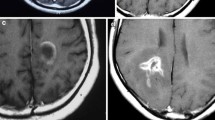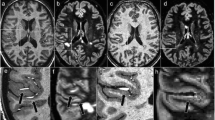Abstract
Acute demyelinating lesions occur in various inflammatory disorders of the CNS. Apart from multiple sclerosis, most cases can be attributed to an overshooting immunological response to infectious agents called acute disseminated encephalomyelitis (ADEM). ADEM, which is mostly characterized by a monophasic course, has a multiphasic variant (MDEM). The early application of corticosteroids has been shown to be beneficial for the outcome; thus, an early diagnosis is highly desirable. Furthermore, the differential diagnosis ruling out neoplastic disorders may be difficult using conventional MRI alone. The potential diagnostic value of advanced MR techniques such as chemical shift imaging (CSI) and diffusion-weighted imaging (DWI) was investigated in a patient with MDEM, who had a new lesion in continuity with the initial disease manifestation. CSI was performed at 1.5 T with a long echo time of 135 ms for the evaluation of N-acetyl-aspartate (NAA) and choline (Cho) and with short TE of 30 ms for macromolecules (mm) and myo-Inositol (mI). DWI was performed using a single-shot isotropic EPI sequence. Whereas acute and chronic areas of demyelination were neither distinguishable on T2- nor on contrast-enhanced T1-weigted images, CSI and DWI revealed different metabolite concentrations and diffusion characteristics within the composite lesion, clearly separating acute from chronic areas of demyelination. In conclusion, the addition of CSI and DWI may add to the diagnostic power of MRI in the setting of demyelinating disorders by identifying areas of acute and chronic demyelination, even in the absence of contrast enhancement.



Similar content being viewed by others
References
Dale RC, de Sousa C, Chong WK, Cox TC, Harding B, Neville BG (2000) Acute disseminated encephalomyelitis, multiphasic disseminated encephalomyelitis and multiple sclerosis in children. Brain 123:2407–2422
Murthy SN, Faden HS, Cohen ME, Bakshi R (2002) Acute disseminated encephalomyelitis in children. Pediatrics 110:e21
Mader I, Seeger U, Weissert R, Klose U, Naegele T, Melms A, Grodd W (2001) Proton MR spectroscopy with metabolite-nulling reveals elevated macromolecules in acute multiple sclerosis. Brain 124:953–961
Mader I, Herrlinger U, Klose U, Schmidt F, Kuker W (2003) Progressive multifocal leukoencephalopathy: analysis of lesion development with diffusion-weighted MRI. Neuroradiology 45:717–721
Seeger U, Mader I, Nagele T, Grodd W, Lutz O, Klose U (2001) Reliable detection of macromolecules in single-volume 1 H NMR spectra of the human brain. Magn Reson Med 45:948–954
Mader I, Stock KW, Ettlin T, Probst A (1996) Acute disseminated encephalomyelitis: MR and CT features. AJNR Am J Neuroradiol 17:104–109
Tenembaum S, Chamoles N, Fejerman N (2002) Acute disseminated encephalomyelitis: A long-term follow-up study of 84 pediatric patients. Neurology 59:1224–1231
Khong PL, Ho HK, Cheng PW, Wong VC, Goh W, Chan FL (2002) Childhood acute disseminated encephalomyelitis: the role of brain and spinal cord MRI. Pediatr Radiol 32:59–66
Lassmann H (2003) Hypoxia-like tissue injury as a component of multiple sclerosis lesions. J Neurol Sci 206:187–191
Huseby ES, Liggitt D, Brabb T, Schnabel B, Ohlen C, Goverman J (2001) A pathogenic role for myelin-specific CD8(+) T cells in a model for multiple sclerosis. J Exp Med 194:669–676
Leclerc X, Huisman TA, Sorensen AG (2002) The potential of proton magnetic resonance spectroscopy ((1)H-MRS) in the diagnosis and management of patients with brain tumors. Curr Opin Oncol 14:292–298
Mader I, Seeger U, Karitzky J, Erb M, Schick F, Klose U (2002) Proton magnetic resonance spectroscopy with metabolite nulling reveals regional differences of macromolecules in normal human brain. J Magn Reson Imaging 16:538–546
Author information
Authors and Affiliations
Corresponding author
Rights and permissions
About this article
Cite this article
Küker, W., Ruff, J., Gaertner, S. et al. Modern MRI tools for the characterization of acute demyelinating lesions: value of chemical shift and diffusion-weighted imaging. Neuroradiology 46, 421–426 (2004). https://doi.org/10.1007/s00234-004-1203-5
Received:
Accepted:
Published:
Issue Date:
DOI: https://doi.org/10.1007/s00234-004-1203-5




